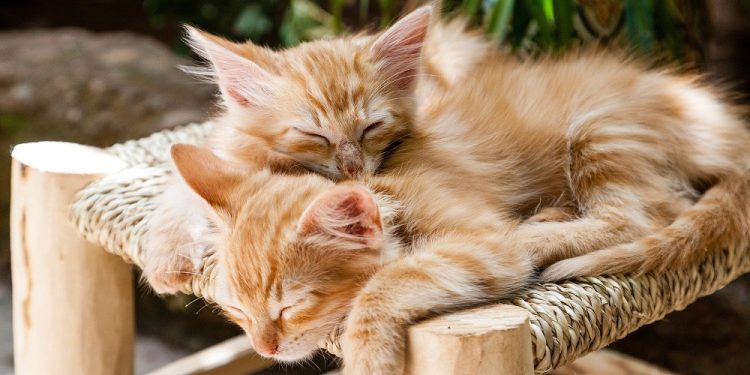
National Cat Day
National Cat Day, which is observed on the 29th of October in the U.S., is a holiday during which people take time to appreciate their cats. However, it’s not just a day when people treat their feline friends well; it’s also a holiday that attempts to shed light on the millions of cats who are abandoned and end up in shelters every year.
This day has been observed since 2005, and we find that quite surprising. After all, cats have been domesticated by humans for at least the past 12,000 years, so you would think that they would have had their own day much sooner than the turn of the 21st century.
The History Of National Cat Day
National Cat Day was initially created by Colleen Paige in 2005. Colleen Paige, an animal welfare advocate, wanted to create a day to help people recognize just how many cats were abandoned each year and needed to be rescued.
She also wanted to create a day that shows people the kind of unconditional love and companionship they can receive from a cat. And in both of those instances, we think that she succeeded in her goals.
The History Of Cat Domestication
Cats are the only domesticated species in the Felidae family, and scientists believe that cats were domesticated about 9,500 years ago. It’s believed that the earliest domestication of a cat was of an African wildcat in southern Cyprus. The remains of a Neolithic grave in Shillourokambos provide evidence for such a theory.
Since Cyprus likely had no native mammals, the humans who lived there may have brought the cat, as well as other wild animals, to the island from the mainland of the Middle East. Of course, this does beg the question: why were cats domesticated in the first place? To determine that, we have to find out why African wildcats were attracted to human settlements in the first place.
Some scientists believe that human agriculture in the Fertile Crescent region of the Middle East attracted rodents—especially the small house mouse—and with the rodents, African cats were attracted to the settlements as well.
In this arrangement, both humans and cats would benefit. The cats would have access to rodents and whatever scraps they received from humans, and the humans would have their rodent problem solved. As human settlements spread across the region, so did the domestication and distribution of domestic cats.
In 1200 B.C., Carthaginian, Etruscan, Greek, and Phoenician traders introduced these domestic cats to Southern Europe. Around 1000 B.C., they were introduced to Corsica and Sardinia. By the end of the fall of the Roman Empire, Egyptian domestic cats could also be found in northern Germany.
As these cats were domesticated, they underwent some gradual and minor changes in their behavior and anatomy. However, it should also be noted that some of the characteristics they already had made them suitable for selection for domestication.
For example, they were smaller than other wild cats and were more social. As humans domesticated them, they took on a variety of other traits that were refined over the years and vary from region to region.
During the Middle Ages, striped and blotched coat markings started appearing in domesticated tabby cats. The gene responsible for producing this coat dates back to Southwest Asia during the Ottoman Empire. It would later become common in Africa and throughout Europe.
However, it wasn’t until the 1700s that these markings on tabby cats became common enough that they began to be associated with house cats. During the 19th century, breeders began to selectively breed certain types of cats to create one of the hundreds of cat breeds that exist today.
Fascinating & Amazing Facts About Cats
As we did our due diligence for this holiday, we came across some interesting and amazing facts about cats. Information that we’d like to share with anyone reading this right now. We believe the following facts will give everyone celebrating this holiday some fine trivia to share with friends and family. Now let’s enjoy some of the amazing facts.
According to the latest research, a house cat shares over 95% of its genome with tigers. This gives tigers and house cats similar behaviors such as urine marking, prey stalking, and scratching.
- Something else that tigers and house cats have in common is chinning—this is when the cat reacts to certain scents by rubbing its chin on the ground.
- House cats are believed to be the only mammals that can’t taste sweetness.
- Cats are not only equipped with whiskers on their faces but also on the backs of their front legs as well.
- Cats’ tongues are rough enough that they can strip the meat off a bone.
- Cats can leap up to six times their length.
- Approximately 40% of cats are either left-pawed or right-pawed. The other 60% are ambidextrous.
- Cats will refuse food that they don’t like, even to the point of starvation.
- Male cats that have been neutered need fewer calories than male cats that haven’t been.
- Cats can vocalize over 100 different sounds. Compare that with the average dog, which only has about 10 different vocalizations.
- When cats wag their tails, it’s a warning that you are antagonizing them.
- When a cat drapes its tail over a human or another pet, it’s a genuine sign of friendship.
- A collective of cats all gathered together is known as a “kindle.”
- Other words for a collective of cats include clutter, clowder, and glaring.
- In Denmark in 1995, a green cat was born. Some people believe that its fur was green due to the high levels of copper found in nearby water pipes.
- The female cat releases multiple eggs over the course of a few days, so kittens in the same litter can have different fathers.
- Cats have caused the extinction of over 34 different bird and animal species.
- During the Clinton administration, it’s been said that the White House cat named Socks received more letters than U.S. President Bill Clinton did.
- Like a dog, every cat’s nose print is unique.
- In the absence of freshwater, cats can survive on saltwater. Human beings cannot.
- A cat can learn as quickly as a 3-year-old human child.
Customs, Traditions, And Celebrations
Celebrating this day is as easy as doing something nice for your cat, for your neighbor’s cat, or for your favorite animal welfare organization. For example, you can adopt a cat from a shelter on this day, buy your cat a fun new toy or treats, assist an elderly person by cleaning out their cat box, hire a photographer to take a picture of your cat, or spend some time volunteering at a local cat shelter.
Any of these actions are great ways to celebrate the cat and its contribution to humans. What are you going to do on National Cat Day? Let everyone know by using the hashtag #NationalCatDay on your social media accounts.








